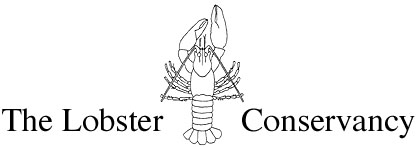
P.O. Box 235, Friendship, ME 04547 (207) 832-8224 www.lobsters.org

P.O. Box 235, Friendship, ME 04547 (207) 832-8224 www.lobsters.org
December 18, 2000
Dear Volunteers and Friends of The Lobster Conservancy,
Here's a wrap up of what has been another banner year for The Lobster Conservancy
Research News
Volunteer Program
Volunteers in the Baby Lobster Watch program are taking a well-deserved
break from field sampling after finishing up their lobster monitoring this fall.
TLC is indebted to the more than 60 volunteers who went out monthly at crazy
times of day and night to collect data on the distribution and abundance of
recently-settled and juvenile lobsters at 23 nursery sites in Maine, New Hampshire
and Massachusetts. Some of these volunteers have been contributing their services
since 1995, while others joined on this year. Thank you all.
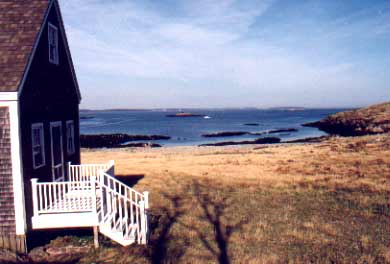
View from the tagging lab overlooking field site on Allen Island
in Muscongus Bay. Photo by Diane F. Cowan
With help from Jane Roundy and Greg Kibitz who have been entering the remaining Year 2000 data, Sara and Diane have begun preliminary analyses. Between May and November 2000, TLC volunteers captured and measured 1,240 lobsters ranging in size from 4 to 86 mm carapace length (CL). The 6 highest densities of early benthic phase lobsters (< 40 mm CL) were observed at Allen Island in Muscongus Bay, Wells Beach in southern Maine, Jaquish Island and Broad Cove in Casco Bay, and Lanesville and Marblehead in Massachusetts (0.70 –1.45 lobsters per m2, respectively). We will continue analyzing data during the winter and, with the good graces of TLC Web Master Al Stewart, reports will be posted on our web site when available (www.lobsters.org/research.html).

Mike Wall sampling a quadrat along his transect line on Allen
Island. Photo by Diane F. Cowan
Tagging of Juvenile Lobsters
Diane is continuing to collect year-round data on growth and movements of tagged
juvenile lobsters at two sites: Lowell's Cove in Casco Bay, Maine and Friendship
Long Island in Muscongus Bay, Maine. A new scientific paper based on this work
entitled "Optimal seasonal sampling for estimating an interannual trend"
by Andrew R. Solow, Andrew Beet, and Diane F. Cowan was recently accepted by
the Israeli Journal of Zoology.

Mike Wall reading new decimal-coded microwire tags. Photo
by Diane F. Cowan
With support from Up East Foundation, tagging has begun at a third site, Allen Island in Muscongus Bay. This fall, Diane trained volunteer Mike Wall to do the tagging, using new and improved decimal-coded micro-wire tags. Mike is a natural and these new tags are fantastic since the numbers can be read directly from the tags, as opposed to the previous more cryptic bar code system. To learn more about the tags you can visit the web site of Northwest Marine Technology (www.nmt-inc.com/Products/CWT/cwt.html).
Lobster Life Study Center
We are happy to report that, after months of preparation, the first research
lobsters are now roaming freely in the pound at the Lobster Life Study Center.
This progress was thanks to the many folks who helped out around the pound this
summer and fall including Miles and Stephanie Jameson, Brock Richardson, John
and Mary Watkins, Venca Borst, Sara and Carolyn West, Dan and Arilda Densch,
Sarah and Tom Arnold, Tim Dwyer, Dana Carter, Teddy Coates, and Dave Starr.
Special thanks go to Friendship lobstermen Henry Thompson, Sr. and Gerry Lane,
as well as Robert Williams of Stonington for donating lobsters for our research.
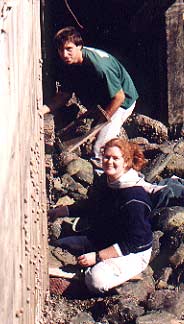
Teddy Coates and Dana Carter apply cement to the oak slots
on the dam to prevent infestation by shipworms. Photo by Diane F. Cowan
This fall, Professor Joe Kunkel of the University of Massachusetts at Amherst continued to analyze serum proteins of lobsters at our research facility. The primary objective of this collaborative project is to determine the health and reproductive condition of lobsters based on "blood" samples. Special thanks to Joe's son Peter and wife Gerda who worked as research assistants.
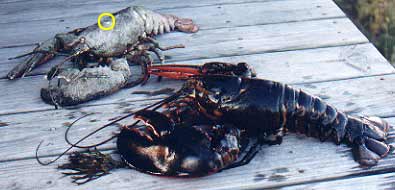
Freshly molted seven pound lobster alongside its molt shell.
Nickel (circled) on back of molt shell for scale. Photo by Diane F. Cowan
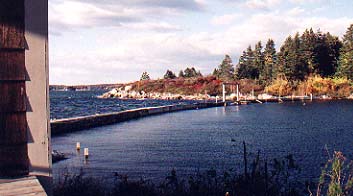
Above:
Lobster pound dam at a normal high tide. Below: Lobster pound dam submerged
during storm tide. Photos by Diane F. Cowan.
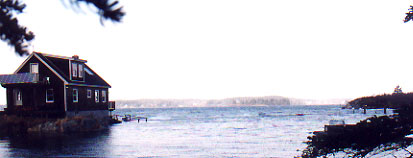
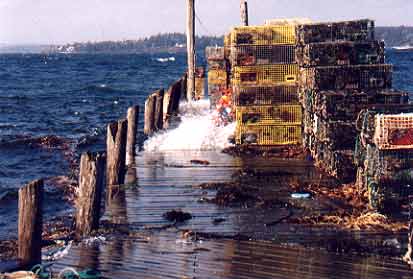
Wharf at Lobster Life Study Center during December storm. Photo by Diane
F. Cowan
Outreach and Education
Bowdoin College students in Professor Ed Laine's Geology class completed their
service-learning project for TLC. Students Brendan Dickinson, Jonathan Ellinger,
Elliot Jacobs, Julie Karlson, Sanida Kikic, Emily Scott, Ellen Strickland and
Sadie Weischhoff braved nasty weather at odd hours to collect data on substrate,
biota, and rocks in Lowell's Cove. Their project featured comparisons between
areas where lobsters were likely to be found versus sites without lobsters.
They presented their results at a poster session at Bowdoin on December 8 and
plan to post their final report on the web. Thanks especially to Service Learning
Coordinator Cathryn Field for acting as a liaison between the students and TLC.
Freelance writer Meg Warren of Brunswick recently wrote a web-based article on lobster science for Riverdeep, an educational portal featuring math and science for K through 12 students (www.riverdeep.net). The article features work by The Lobster Conservancy as well as Lew Incze and Rick Wahle of Bigelow Laboratory. To research the article Warren observed and assisted TLC volunteers Polly Wilson, Anne Barrett, and Corie Bibber Logan in the field.
Press Coverage
In November, lobsterman Peter Prybot wrote an article for the Gloucester Daily
Times entitled "Lanesville team contributes to interstate lobster research."
The article features the adventures of TLC volunteers Pat Earle, Astrid and
Carson af Klinteberg, and Cindy Dunn.
Keep an eye out for some upcoming articles on The Lobster Conservancy in Islands magazine (due out in March), the Chronicle of Higher Learning, and European news magazine Der Speigel. Please alert us if you see them before we do. Over the winter we will post new articles on the press page of our web site (www.lobsters.org/press/press.php), so surf on in once in a while.
Biologist Dan Yule of Northwest Marine Technology, the company that makes the microwire tags we use, has posted an article on the company's web page (www.nmt-inc.com/Applications/CWT/Lobster/Lobster.html) about Diane's pioneering method of multiple tag-and-recapture of juvenile lobsters.
Do you read "Ask the Lobster Doc?" Since April 1999, Diane has been writing a monthly column for fishermen in Commercial Fisheries News detailing interesting facts on lobster biology. Pick up Commercial Fisheries News at your local newsstand to learn more about these fascinating creatures. You can also read archived version of these articles on our website (www.lobsters.org/ldoc/ldocindx.php).
Grant Announcements
Things are shaping up well for TLC for 2001. We thank Darden Environmental Trust
and the Michael D. Dingman Foundation for general support of our research programs
next year. Maine Community Foundation is graciously acknowledged for supporting
our proposal for Strategic Planning to help chart TLC's future course. We are
also pleased to report that we have received grants to continue our long-term
research on juvenile lobsters from the Gulf of Maine Council on the Marine Environment,
Greater Piscataqua Community Foundation, and Up East Foundation – thank
you. We are thankful to Davis Conservation Foundation for supporting our research
on reproductive biology of adult lobsters at the Lobster Life Studies Center.
We are still trying to raise matching funds for our research projects. We are
also pleased to announce that Maine Sea Grant will be supporting a new collaborative
project between TLC, New England Aquarium, and Maine Department of Marine Resources
entitled "Environmental impacts of lobster pounds: monitoring impacts,
modeling holding capacity, and assessing policy."
Fund Raising
With the holiday season upon us, you may be searching for unique gifts that
support a good cause. Look no further! The Lobster Conservancy can offer some
fresh ideas. Our newest gift item is a T-Shirt with a red cartoon of a lobster
family and the words "The Lobster Conservancy; We're Counting on You."
The shirts, designed by Steve Alexander, are white Hanes Beefy-Ts and come in
Medium, Large and X-Large. These are priced to sell at $13. TLC also sells low-profile
caps that sport a red lobster and the words "The Lobster Conservancy, Friendship,
Maine." Hats are khaki with either blue or green brims and are priced at
$18 (all prices include shipping). You can take a look at these gifts and print
out mail-in order forms at www.lobsters.org/tlcstuff.html.
Our Adopt-a-Lobster program continues to be a popular gift. Lobsters' "parents" receive a certificate of adoption, a description of their lobsters, color photos of representative lobsters, and periodic updates. The adoption program helps support our tag-and-release program, which is entering its 9th year. For more information, visit our web site, or contact us directly by phone (207-832-8224) or e-mail.
Finally, a huge thank you to the individuals and local businesses who were able to respond to our recent Annual Appeal. As our organization grows so does our need for new sources of support, and donations of any size are very helpful. If you are receiving this newsletter by e-mail, but did not receive our Annual Appeal letter, it means we don't have your correct snail-mail address in our files. Please let us know if you would like to receive future mailings by sending us your current address.
Thanks once again to all the volunteers who shared in our research programs this year. We wish you and your loved ones safe and happy holidays and all the best for the New Year.
Yours in TLC and Friendship,
Sara Ellis, Executive Director and Diane Cowan, Senior Scientist